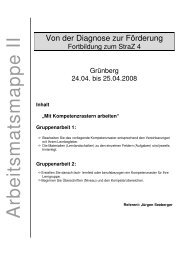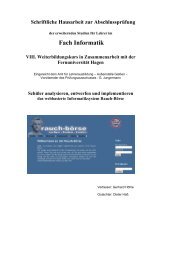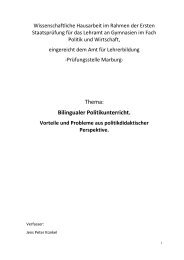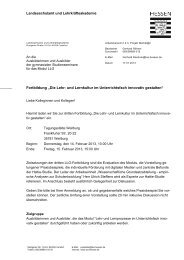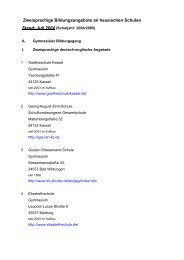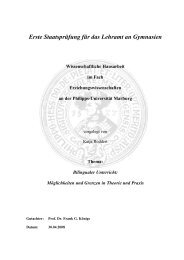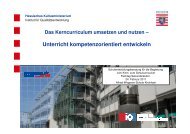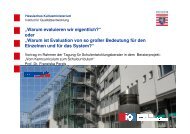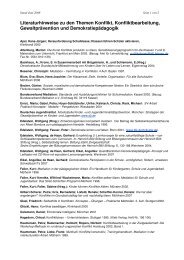- Page 1 and 2: PROFILING EUROPEAN CLIL CLASSROOMS
- Page 3 and 4: PROFILING EUROPEAN CLIL CLASSROOMS
- Page 5 and 6: ACKNOWLEDGEMENTS The realization of
- Page 7 and 8: 8 We shall not cease from explorati
- Page 9: The Past Decade and the Next Millen
- Page 13 and 14: PART 1 Dimensions of Content and La
- Page 15 and 16: RATIONALE European CLIL is highly d
- Page 17 and 18: The Culture Dimension CULTIX Build
- Page 19 and 20: CULTIX Develop Intercultural Commun
- Page 21 and 22: CULTIX Learn about Specific Neighbo
- Page 23 and 24: CULTIX Introduce the Wider Cultural
- Page 25 and 26: The Environment Dimension ENTIX Pre
- Page 27 and 28: ENTIX Access International Certific
- Page 29 and 30: ENTIX Enhance School Profile Some s
- Page 31 and 32: The Language Dimension LANTIX Impro
- Page 33 and 34: LANTIX Develop Oral Communication S
- Page 35 and 36: LANTIX Deepen Awareness of Both Mot
- Page 37 and 38: LANTIX Develop Plurilingual Interes
- Page 39 and 40: LANTIX Introduce a Target Language
- Page 41 and 42: The Content Dimension CONTIX Provid
- Page 43 and 44: CONTIX Access to Subject-specific T
- Page 45 and 46: CONTIX Prepare for Future Studies a
- Page 47 and 48: The Learning Dimension LEARNTIX Com
- Page 49 and 50: LEARNTIX Diversify Methods & Forms
- Page 51 and 52: LEARNTIX Increase Learner Motivatio
- Page 53 and 54: DIMENSIES VAN TWEETALIG ONDERWIJS 1
- Page 55 and 56: 58 CULTIX Bouwen van Interculturele
- Page 57 and 58: 60 CULTIX Ontwikkelen van Intercult
- Page 59 and 60: CULTIX Leren over Buurlanden / Stre
- Page 61 and 62:
64 CULTIX Introductie van een Brede
- Page 63 and 64:
66 ENTIX Voorbereiding op Internati
- Page 65 and 66:
68 ENTIX Toegang tot Internationale
- Page 67 and 68:
70 ENTIX Profilering van de School
- Page 69 and 70:
LANTIX Bevorderen van Algemene Taal
- Page 71 and 72:
74 LANTIX Ontwikkelen van Mondeling
- Page 73 and 74:
76 LANTIX Bewustwording van zowel d
- Page 75 and 76:
78 LANTIX Ontwikkelen van Meertalig
- Page 77 and 78:
80 LANTIX Introductie van de Doelta
- Page 79 and 80:
82 CONTIX Bieden van Mogelijkheden
- Page 81 and 82:
84 CONTIX Toegang tot Jargon in de
- Page 83 and 84:
CONTIX Voorbereiding op Toekomstige
- Page 85 and 86:
88 LEARNTIX Vergroten van het Reper
- Page 87 and 88:
LEARNTIX Vergroten van de Variëtei
- Page 89 and 90:
92 LEARNTIX Bevorderen van de Motiv
- Page 91 and 92:
PART 3 Vieraskielisen opetuksen tot
- Page 93 and 94:
JOHDANTO Eurooppalaiset vieraskieli
- Page 95 and 96:
Kulttuurinen dimensio CULTIX Kulttu
- Page 97 and 98:
CULTIX Kulttuurienväliseen kommuni
- Page 99 and 100:
CULTIX Tietous naapurimaista/alueis
- Page 101 and 102:
CULTIX Laajemman kulttuurisen viite
- Page 103 and 104:
Yhteisöllinen dimensio ENTIX Kansa
- Page 105 and 106:
ENTIX Kansainväliseen tutkintoon t
- Page 107 and 108:
ENTIX Koulun profiloituminen Koulua
- Page 109 and 110:
Kielellinen dimensio LANTIX Kohdeki
- Page 111 and 112:
LANTIX Suullisen kielitaidon kehitt
- Page 113 and 114:
LANTIX Äidinkielen ja kohdekielen
- Page 115 and 116:
LANTIX Monikielisyyttä tukevien as
- Page 117 and 118:
LANTIX Kohdekielen esitteleminen T
- Page 119 and 120:
Sisällöllinen dimensio CONTIX Ope
- Page 121 and 122:
CONTIX Aine- ja aihekohtainen viera
- Page 123 and 124:
CONTIX Valmistautuminen jatko-opint
- Page 125 and 126:
Oppimisen dimensio LEARNTIX Yksilö
- Page 127 and 128:
LEARNTIX Opetusmetodien ja -käytä
- Page 129 and 130:
LEARNTIX Oppimismotivaation lisää
- Page 131 and 132:
DIMENSIONS ET PRINCIPAUX ASPECTS DE
- Page 133 and 134:
138 CULTIX Développement de la con
- Page 135 and 136:
140 CULTIX Développement des aptit
- Page 137 and 138:
142 CULTIX Découverte de régions
- Page 139 and 140:
144 CULTIX Elargissement du context
- Page 141 and 142:
146 ENTIX Préparation à l´intern
- Page 143 and 144:
148 ENTIX Obtention de reconnaissan
- Page 145 and 146:
ENTIX Amélioration du profil de l
- Page 147 and 148:
LANTIX Amélioration générale de
- Page 149 and 150:
154 LANTIX Développer les aptitude
- Page 151 and 152:
GROUPE D'AGE 5-15 ans 5-15 ans 5-15
- Page 153 and 154:
158 LANTIX Elargissement des intér
- Page 155 and 156:
160 LANTIX Introduction d´une lang
- Page 157 and 158:
162 CONTIX Ouverture de diverses pe
- Page 159 and 160:
GROUPE D'AGE 5-15 ans 14-20 ans MIL
- Page 161 and 162:
CONTIX Préparation à des études
- Page 163 and 164:
168 LEARNTIX Elargissement du répe
- Page 165 and 166:
170 LEARNTIX Encouragement à la va
- Page 167 and 168:
172 LEARNTIX Progression de la moti
- Page 169 and 170:
PART 5 Dimensionen inhaltsbezogenen
- Page 171 and 172:
GRUNDLAGE In den mehrsprachigen Bil
- Page 173 and 174:
CULTIX Aufbau von interkulturellem
- Page 175 and 176:
CULTIX Entwicklung interkultureller
- Page 177 and 178:
CULTIX Lernen über spezifische Nac
- Page 179 and 180:
CULTIX Erschließen des weiteren ku
- Page 181 and 182:
Die Dimension der Umgebung ENTIX Vo
- Page 183 and 184:
ENTIX Erwerb internationaler Qualif
- Page 185 and 186:
ENTIX Ausbau des Schulprofils Manch
- Page 187 and 188:
Beispiele Die sprachliche Dimension
- Page 189 and 190:
LANTIX Entwicklung mündlicher Komm
- Page 191 and 192:
LANTIX Förderung der Sprachbewusst
- Page 193 and 194:
LANTIX Entwicklung sprachübergreif
- Page 195 and 196:
LANTIX Einführung einer Zielsprach
- Page 197 and 198:
Die inhaltliche Dimension CONTIX Er
- Page 199 and 200:
CONTIX Erwerb zielsprachlicher Fach
- Page 201 and 202:
CONTIX Vorbereitung auf späteres S
- Page 203 and 204:
Die Lerndimension LEARNTIX Ausbau d
- Page 205 and 206:
LEARNTIX Förderung von Methoden- u
- Page 207 and 208:
LEARNTIX Steigerung der Lernermotiv
- Page 209 and 210:
DIMENSIONES Y ENFOQUES DE LOS PROGR
- Page 211 and 212:
218 CULTIX Construye conocimiento y
- Page 213 and 214:
CULTIX Desarrolla las habilidades q
- Page 215 and 216:
222 CULTIX Da a conocer regiones o
- Page 217 and 218:
224 CULTIX Amplia el contexto cultu
- Page 219 and 220:
226 ENTIX Prepara para la internaci
- Page 221 and 222:
228 ENTIX Prepara para obtener tít
- Page 223 and 224:
230 ENTIX Mejora el perfil de la es
- Page 225 and 226:
LANTIX Mejora la competencia lingü
- Page 227 and 228:
234 LANTIX Desarrolla las habilidad
- Page 229 and 230:
236 LANTIX Sensibiliza tanto hacia
- Page 231 and 232:
238 LANTIX Desarrolla intereses y a
- Page 233 and 234:
240 LANTIX Introduce una nueva leng
- Page 235 and 236:
242 CONTIX Diversifica las perspect
- Page 237 and 238:
244 CONTIX Presenta terminología t
- Page 239 and 240:
CONTIX Prepara para estudios poster
- Page 241 and 242:
248 LEARNTIX Desarrolla las estrate
- Page 243 and 244:
250 LEARNTIX Diversifica las práct
- Page 245 and 246:
252 LEARNTIX Aumenta la motivación
- Page 248 and 249:
The CLIL Compendium partnership wou
- Page 250:
Ms/Mr Thery Germany Riitta Tiikasal



